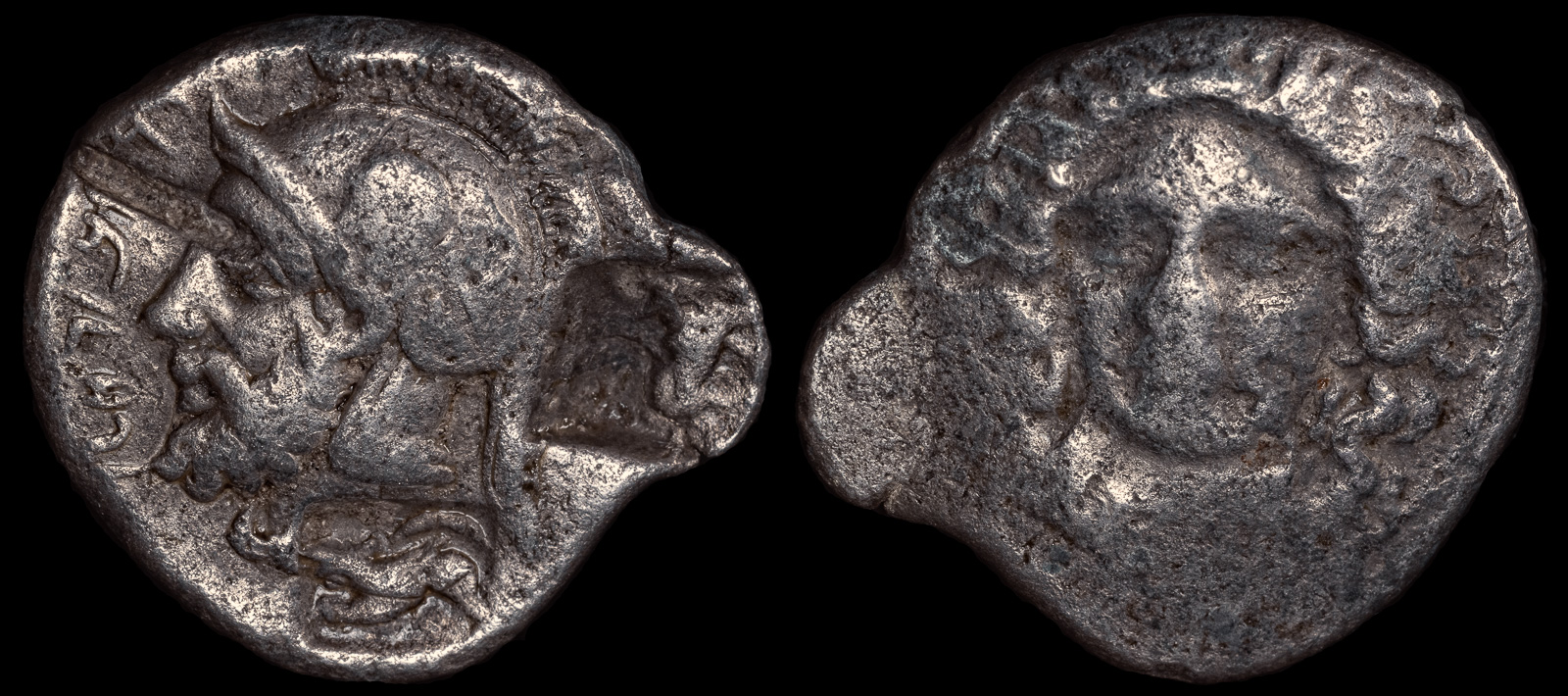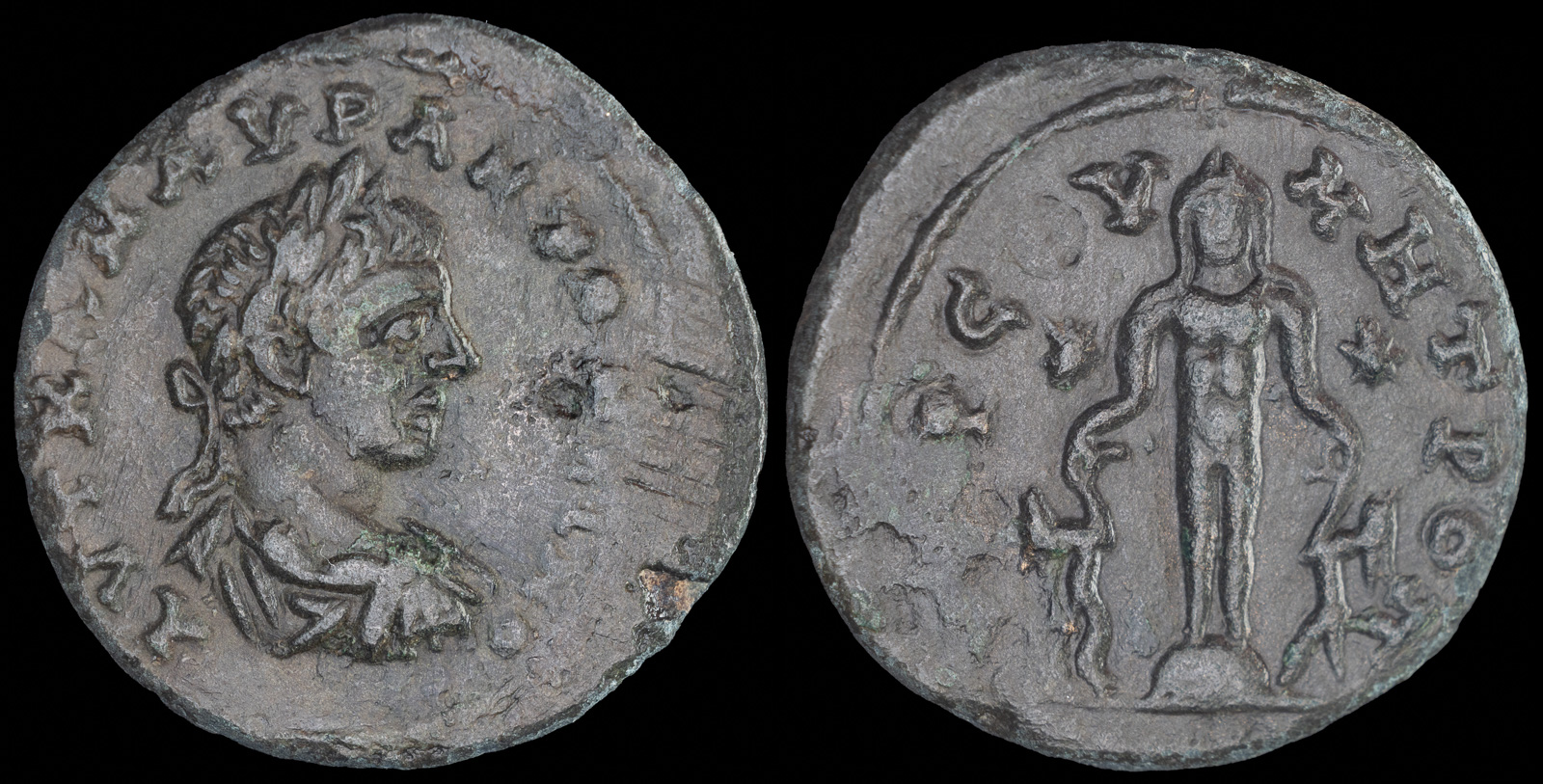
Cilicia, Tarsos: Pharnabazos
379-374 BCE
AR stater, 24mm, 10.3 g
Female head facing
Bearded and helmeted head left, test cut and two countermarks, one of bull crossing (with crescent?) and one of wolf leaping with crescent at rear (Callatay countermarks B and C)
SNG Cop. 266
Tarsos was perhaps the most important city in Cilicia and archeological and historical evidence points to it being ancient and having been first settled thousands of years ago.

Cilicia, Tarsos
AR Stater 10.62g, 20mm, 9h.
Circa 440-400 BCE
Horseman (Syennesis?) riding to left, wearing kyrbasia, holding lotus flower in right hand and reins in left, bow in bowcase on saddle; key symbol below horse, eagle(?) standing to left behind / Archer in kneeling-running stance to right, quiver over shoulder, drawing bow; key symbol behind, ‘trz’ in Aramaic on the lower right; all within dotted border within incuse square
BMC -; SNG von Aulock -; SNG Copenhagen -; SNG Levante -; SNG BnF -, cf. 213 for types = Casabonne Type D2, pl. 2, 10 = MIMAA pl. V, 6 = Traité II, 523
While there are many legends concerning its founding, in truth the city predates all of them. One states that Bellerophon fell off Pegasos here and hurt his foot, with ‘Tarsos’ meaning ‘sole of the foot’. Another has Herakles being imprisoned here, likely the reason for some coins bearing his image. There are some who believe Tarsos to be the located of the Biblical Tarshish, though that is disputed.

Tarsos. Mazaios, Satrap. Circa 361-334 BC. AR Stater.
Baaltars seated left, holding sceptre surmounted by an eagle in right hand,
left arm at side; grain ear, bunch of grapes to left, monogram under throne
/ Lion attacking bull above double row of turreted walls.
10.11g
SNG Levante 113; SNG France 360
Alexander the Great passed through the city in 333 BCE, and this was where he nearly died while swimming in the river Kydnos. When he entered the water, his body began to chill and he suddenly fell unconscious. Luckily, being the king, he wasn’t alone and his attendants carried him back to his tent, where he recovered.

Cilicia, Tarsos AR Stater.
Balakros, satrap of Cilicia under Alexander III.
Circa 333-323 BCE
Facing bust of Athena, draped, wearing triple-crested helmet and necklace / Baaltars seated to left, holding lotus-tipped sceptre; grain ear and grape bunch to left, B above ivy leaf to right, T below throne.
SNG Levante Suppl. 21; SNG BnF 368; SNG von Aulock 5964.
10.79g, 26mm, 6h
After his death, Tarsos became part of the Seleukid Empire.
I have several coins from Tarsos. The first is from Pharnabazos, who ruled the city after his skirmish with Xenophon and his 10,000. Laster, Mazaios received the satrapy. When Alexander conquered the region, Mazaios capitulated and was given the satrapy of Babylon, while Balakros took his place.

Kilikia, Tarsos
Elagabalus. 218-222 CE
AE Diassarion 7.16g, 25mm
Obv.: AVT KA M AVP ANTΩNINOC, laureate, draped and cuirassed bust right, seen from behind; below, star.
Rev.: TAPCOY MHTPO, Apollo Lykeios standing facing on omphalos, holding a wolf by the forepaw in each hand; to left and right, stars.
SNG Levante 1082; SNG Paris 1559
Syennesis receives gifts from Cyrus the Younger after his troops sack his capital of Tarsos.
Alexander the Great conquers Cilicia and Pisidia, including Aigai.Tarsos (where he became ill after a swim in the Kydnos River), Soloi, Sagalassos, and Issos.
Following the victory in the Battle of Ipsos, Cilicia comes under Seleukid control with Seleukos I Nikator. This included Aigai.Tarsos, Soloi, Issos, and Mallos.
Mallos and Tarsos ally against Antiochos IV Epiphanes.
Cassius Longinus schemes to kill Julius Caesar at Tarsos.
Kleopatra and Marc Antony meet and have lavish feasts at Tarsos.
October
July
Maximinus Daza dies in Tarsos, possibly due to Graves’ disease.